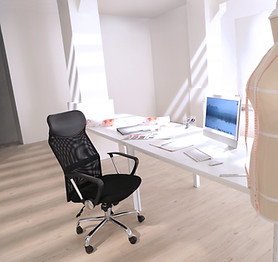yourhealthdomain
Kyle House, Mezzanine Level, 27 Macquarie Place
Sydney NSW 2000
*Willoughby appointments available upon request

Work Station Setup
We regularly see a variety of injuries and disorders arising from improper computer use and poor posture. These include:
-
Headaches and eye strain
-
Neck pain and stiffness
-
Shoulder and arm pain
-
Repetitive Strain Injury (RSI)
-
Wrist, hand and thumb pain
-
Low back pain
Many which are preventable with the correct work station set up. Below our team has outlined a list of guidelines for correct work station step up to ensure an ergonomic at-home or in-office work environment.

Seated Work Station Set Up
Standing Work Station Set Up
The Monitor & Desk
-
Desk height should be determined by arm position
-
Arms should be relaxed, elbows bent at 90 degrees and in by sides
-
Forearms should be parallel to desk
-
Computer screen should be one arms length away from you
-
The first line of text should be eye level
-
The keyboard should be within easy reach zone, wrists should be flat
-
Position mouse in close to keyboard in easy reach zone
-
Telephone positioned in easy reach zone
WHAT WE OFFER
INDIVIDUAL ASSESSMENTS
Our assessments include:
Onsite assessment
Simple changes to work station will be made at the time of assessment
A written report within 5 working days outlining changes made and further recommendations or equipment required
Assistance with ordering of equipment and
Follow-up contact via phone or email to answer any further queries and to ensure the best outcome has been achieved.
SMALL TO LARGE GROUP TRAINING & ASSESSMENT
Our assessments for groups of employees involve the following components:
Online survey
On-site in-service - interactive power point presentation – includes correct sitting and standing posture, correct work station set-up, OH and S regulations, stretch and pause exercises
Individual ergonomic work station assessment – changes made at time of assessment if possible i.e. monitor raised, chair adjusted, desk layout re-arranged if required
Individual reports on findings from assessments including further recommendations/equipment required if necessary
Assistance with ordering and set-up of equipment if required i.e. specific chair recommendation
Attendance report of staff attending in-service
Summary report of equipment required will also be provided to make ordering of equipment (if required) simple and easy for the HR team




